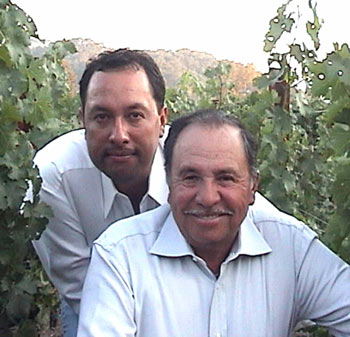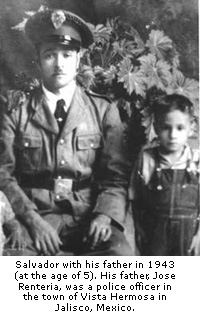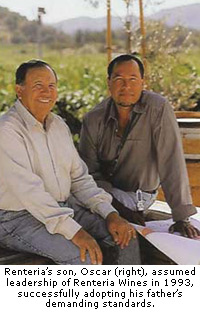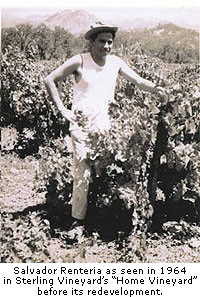

Oscar and Salvador Renteria operate one of California's most successful vineyard management businesses.
Tending the Vines of the Napa Valley: An interview with Salvador and Oscar Renteria
"We felt like we had achieved a certain success in growing grapes, but I felt it wasn’t complete. Obviously, if you grow some great grapes, you can make great wine. There’s an added value there. You get full exposure."
~ Oscar Renteria
by
Alan Goldfarb
November 1, 2006
Alan Goldfarb (AG): Why did you choose to locate your winery on Mt. Veeder?
 Oscar Renteria (OR): For the slopes, the hills, and the uniform terrain, which allows me to produce a range of varietals. It’s a unique site. We’re trying to make lower alcohol wines and wines that are truer to the terroir.
Oscar Renteria (OR): For the slopes, the hills, and the uniform terrain, which allows me to produce a range of varietals. It’s a unique site. We’re trying to make lower alcohol wines and wines that are truer to the terroir.
According to the analysis of the soils, they are extremely uniform and that’s hard to get on hillsides. With that elevation (1,300 feet) I can attain good acidity.
AG: It’s been said, Salvador, that you developed some innovative vineyard techniques. What are those?
Salvador Renteria (SR): In the late ‘60s, we worked with head-pruned vines, no wires, and we were just coming into drip irrigation systems. I worked with UC Davis.
André Tchelistcheff (then the winemaker at BV) used to drive me nuts because of his coffee and his smoking (laughs). Every time he spoke to you, he poured more coffee; and he swore a lot, too. (But he also) showed me cane training.
OR: We didn’t invent it, but we improved it. Everything was new and my father was right there in the middle of it.
AG: I read that Oscar once threatened to quit because he said, you’re “too hard to work with.” Is that true?
 SR: I think so. The story is larger than that. It wasn’t my fault, but he was coming out of school and it wasn’t easy for him to be a farmer. ..What are you going to do, fire your son because he wasn’t going to show up today? The best thing for him was to go work for somebody else.
SR: I think so. The story is larger than that. It wasn’t my fault, but he was coming out of school and it wasn’t easy for him to be a farmer. ..What are you going to do, fire your son because he wasn’t going to show up today? The best thing for him was to go work for somebody else.
The first year it was hard. I don’t know what he did, but I think he got a little smarter. It was kind of hard though. He was ready to quit. When we came home and had dinner, I wanted to talk about work, but he was on the phone talking to all his girlfriends.
AG: When you arrived in the Napa Valley you had never worked on a farm before -- you were trained as a barber and you were a pool shark -- and ’62 was a very wet year and you left, saying, “This is not for me.”
SR: I went back to my barbershop but I came back in ’64. I still don’t know why I came back. I didn’t want to go back to Chicago (where he hustled pool). It was too cold.
I went back to Napa and gave it another try. I liked it. Within a few months, they made me a crew leader and I had a little more responsibility. I had learned a little English back home and I was able to communicate with the people around me.
 AG: Oscar, why did you decide to finally produce wine? Was it because you once said, "… growing grapes, there's not a lot of exposure. By making wine, you tell a story.”? In other words, is making wine more sexy or interesting to the public than growing grapes?
AG: Oscar, why did you decide to finally produce wine? Was it because you once said, "… growing grapes, there's not a lot of exposure. By making wine, you tell a story.”? In other words, is making wine more sexy or interesting to the public than growing grapes?
OR: By far. You can look at all the tourists that visit the Napa Valley…We felt like we had achieved a certain success in growing grapes, but I felt it wasn’t complete. Obviously, if you grow some great grapes, you can make great wine. There’s an added value there. You get full exposure.
AG: What do you think about your son going into the wine business?
SR: It was always my dream. When I started working for Sterling, I actually made wines in ’73 - 70 cases, from the second crop. I liked it, but I never thought I’d make (my own) wine.
AG: Now, since you farm across so many AVAs of the Napa Valley, and source fruit for your own brand from several, tell me the differences and characteristics of each.
OR: Here are my thoughts:
Calistoga (AVA pending) (Clients are Vine Cliff, Rombauer) -- Here, it is very warm, with soils that are well-drained. Ripening is not an issue, and the region produces extracted wines.
Diamond Mountain (von Strasser, Constant) -- This is one of my favorite appellations. What can you say about mountain fruit and elevation? There are volcanic soils and because of the hillsides, there’s a tremendous amount of control over vigor. Here, the fruit ripens quickly because it’s warm.
Spring Mountain (Keenan, Juslyn) -- Here, there is a later harvest relative to Diamond Mountain. There is an eastern exposure, so it gets morning sun, and has mid-range, moderate ripening. The soils are well-drained -- it is a damn tough appellation to beat.
St. Helena (Rombauer, Silver Oak) -- What I love about St. Helena is that this is the valley floor. It’s extremely well-drained, which means you can control vigor. You can also hang the fruit for maturity for (up to) three weeks. Grapes ripen consistently here year to year.
Howell Mountain (Vine Cliff) -- This is my favorite appellation. I’ve yet to produce a bad year from fruit sourced from Howell Mountain. No misses, nothing but hits. The soils are more distinct -- tufa, volcanic ash -- which are very rich in nutrients.
Chiles Valley -- (no clients)
Pope Valley (not an official AVA) (Michael and Rob Mondavi, Merryvale, Duckhorn, Groth) -- We manage 600 acres here. We’re the largest grower in the appellation. There’s very little difference between Chiles and Pope. Extremes of cold and warmth, we start late, wake up late, and it ripens fast. It is the best Sauvignon Blanc in the valley because of the short cycle of growth.
Rutherford (Silver Oak, Rombauer) -- Cabernet is strong here, so it’s an easy one for us. The appellation has good soils, which are rich in nutrients. Stylistically, it produces an easy, solid Cabernet.
Oakville (Vine Cliff) -- On the hillsides, the best fruit is immaculate. It ripens easily and they can hang there. Stylistically, the wines have less high-heat (alcohol).
Stags Leap District (Baldacci, Rombauer) -- This is the only AVA in the U.S. that was granted because of its soils – well-draining tufa and shale. It is my second favorite appellation because wines here are plush, velvety, approachable, and seem to be better balanced
 Oscar Renteria (OR): For the slopes, the hills, and the uniform terrain, which allows me to produce a range of varietals. It’s a unique site. We’re trying to make lower alcohol wines and wines that are truer to the terroir.
Oscar Renteria (OR): For the slopes, the hills, and the uniform terrain, which allows me to produce a range of varietals. It’s a unique site. We’re trying to make lower alcohol wines and wines that are truer to the terroir.According to the analysis of the soils, they are extremely uniform and that’s hard to get on hillsides. With that elevation (1,300 feet) I can attain good acidity.
AG: It’s been said, Salvador, that you developed some innovative vineyard techniques. What are those?
Salvador Renteria (SR): In the late ‘60s, we worked with head-pruned vines, no wires, and we were just coming into drip irrigation systems. I worked with UC Davis.
André Tchelistcheff (then the winemaker at BV) used to drive me nuts because of his coffee and his smoking (laughs). Every time he spoke to you, he poured more coffee; and he swore a lot, too. (But he also) showed me cane training.
OR: We didn’t invent it, but we improved it. Everything was new and my father was right there in the middle of it.
AG: I read that Oscar once threatened to quit because he said, you’re “too hard to work with.” Is that true?
 SR: I think so. The story is larger than that. It wasn’t my fault, but he was coming out of school and it wasn’t easy for him to be a farmer. ..What are you going to do, fire your son because he wasn’t going to show up today? The best thing for him was to go work for somebody else.
SR: I think so. The story is larger than that. It wasn’t my fault, but he was coming out of school and it wasn’t easy for him to be a farmer. ..What are you going to do, fire your son because he wasn’t going to show up today? The best thing for him was to go work for somebody else.The first year it was hard. I don’t know what he did, but I think he got a little smarter. It was kind of hard though. He was ready to quit. When we came home and had dinner, I wanted to talk about work, but he was on the phone talking to all his girlfriends.
AG: When you arrived in the Napa Valley you had never worked on a farm before -- you were trained as a barber and you were a pool shark -- and ’62 was a very wet year and you left, saying, “This is not for me.”
SR: I went back to my barbershop but I came back in ’64. I still don’t know why I came back. I didn’t want to go back to Chicago (where he hustled pool). It was too cold.
I went back to Napa and gave it another try. I liked it. Within a few months, they made me a crew leader and I had a little more responsibility. I had learned a little English back home and I was able to communicate with the people around me.
 AG: Oscar, why did you decide to finally produce wine? Was it because you once said, "… growing grapes, there's not a lot of exposure. By making wine, you tell a story.”? In other words, is making wine more sexy or interesting to the public than growing grapes?
AG: Oscar, why did you decide to finally produce wine? Was it because you once said, "… growing grapes, there's not a lot of exposure. By making wine, you tell a story.”? In other words, is making wine more sexy or interesting to the public than growing grapes?OR: By far. You can look at all the tourists that visit the Napa Valley…We felt like we had achieved a certain success in growing grapes, but I felt it wasn’t complete. Obviously, if you grow some great grapes, you can make great wine. There’s an added value there. You get full exposure.
AG: What do you think about your son going into the wine business?
SR: It was always my dream. When I started working for Sterling, I actually made wines in ’73 - 70 cases, from the second crop. I liked it, but I never thought I’d make (my own) wine.
AG: Now, since you farm across so many AVAs of the Napa Valley, and source fruit for your own brand from several, tell me the differences and characteristics of each.
OR: Here are my thoughts:
Calistoga (AVA pending) (Clients are Vine Cliff, Rombauer) -- Here, it is very warm, with soils that are well-drained. Ripening is not an issue, and the region produces extracted wines.
Diamond Mountain (von Strasser, Constant) -- This is one of my favorite appellations. What can you say about mountain fruit and elevation? There are volcanic soils and because of the hillsides, there’s a tremendous amount of control over vigor. Here, the fruit ripens quickly because it’s warm.
Spring Mountain (Keenan, Juslyn) -- Here, there is a later harvest relative to Diamond Mountain. There is an eastern exposure, so it gets morning sun, and has mid-range, moderate ripening. The soils are well-drained -- it is a damn tough appellation to beat.
St. Helena (Rombauer, Silver Oak) -- What I love about St. Helena is that this is the valley floor. It’s extremely well-drained, which means you can control vigor. You can also hang the fruit for maturity for (up to) three weeks. Grapes ripen consistently here year to year.
Howell Mountain (Vine Cliff) -- This is my favorite appellation. I’ve yet to produce a bad year from fruit sourced from Howell Mountain. No misses, nothing but hits. The soils are more distinct -- tufa, volcanic ash -- which are very rich in nutrients.
Chiles Valley -- (no clients)
Pope Valley (not an official AVA) (Michael and Rob Mondavi, Merryvale, Duckhorn, Groth) -- We manage 600 acres here. We’re the largest grower in the appellation. There’s very little difference between Chiles and Pope. Extremes of cold and warmth, we start late, wake up late, and it ripens fast. It is the best Sauvignon Blanc in the valley because of the short cycle of growth.
Rutherford (Silver Oak, Rombauer) -- Cabernet is strong here, so it’s an easy one for us. The appellation has good soils, which are rich in nutrients. Stylistically, it produces an easy, solid Cabernet.
Oakville (Vine Cliff) -- On the hillsides, the best fruit is immaculate. It ripens easily and they can hang there. Stylistically, the wines have less high-heat (alcohol).
Stags Leap District (Baldacci, Rombauer) -- This is the only AVA in the U.S. that was granted because of its soils – well-draining tufa and shale. It is my second favorite appellation because wines here are plush, velvety, approachable, and seem to be better balanced














